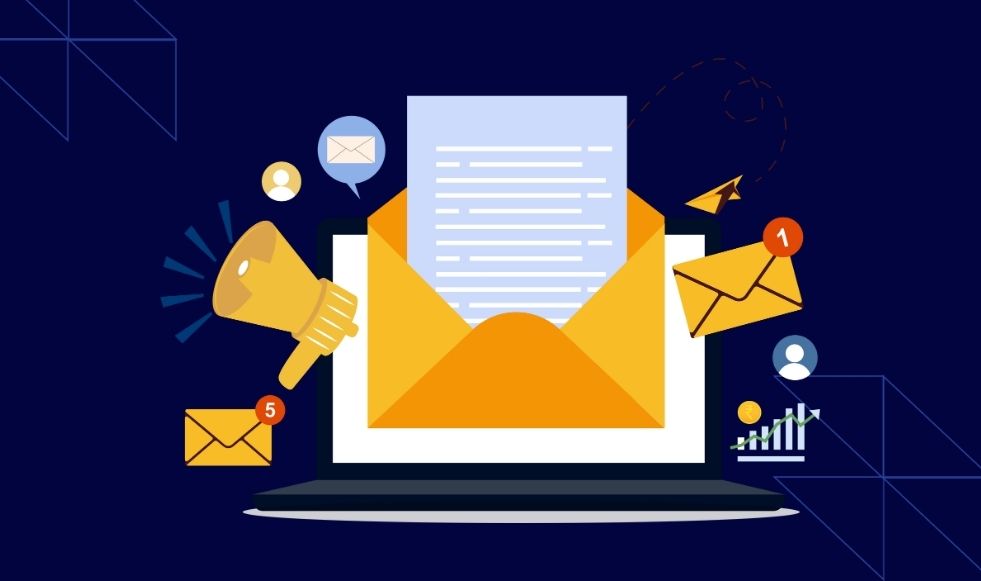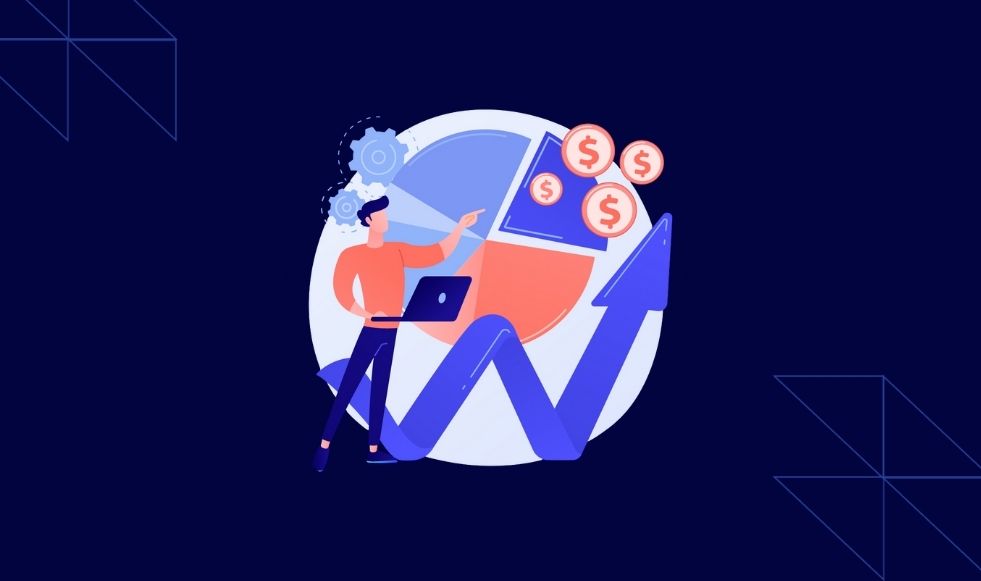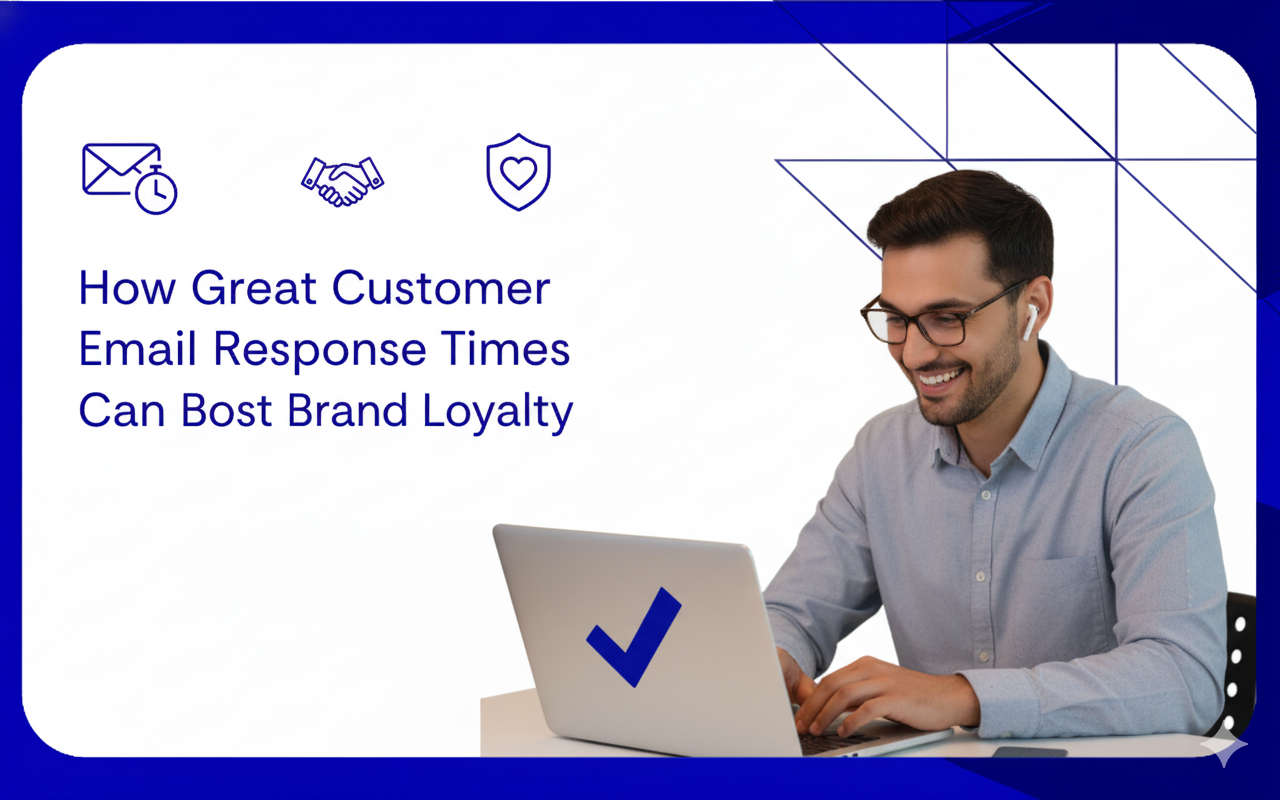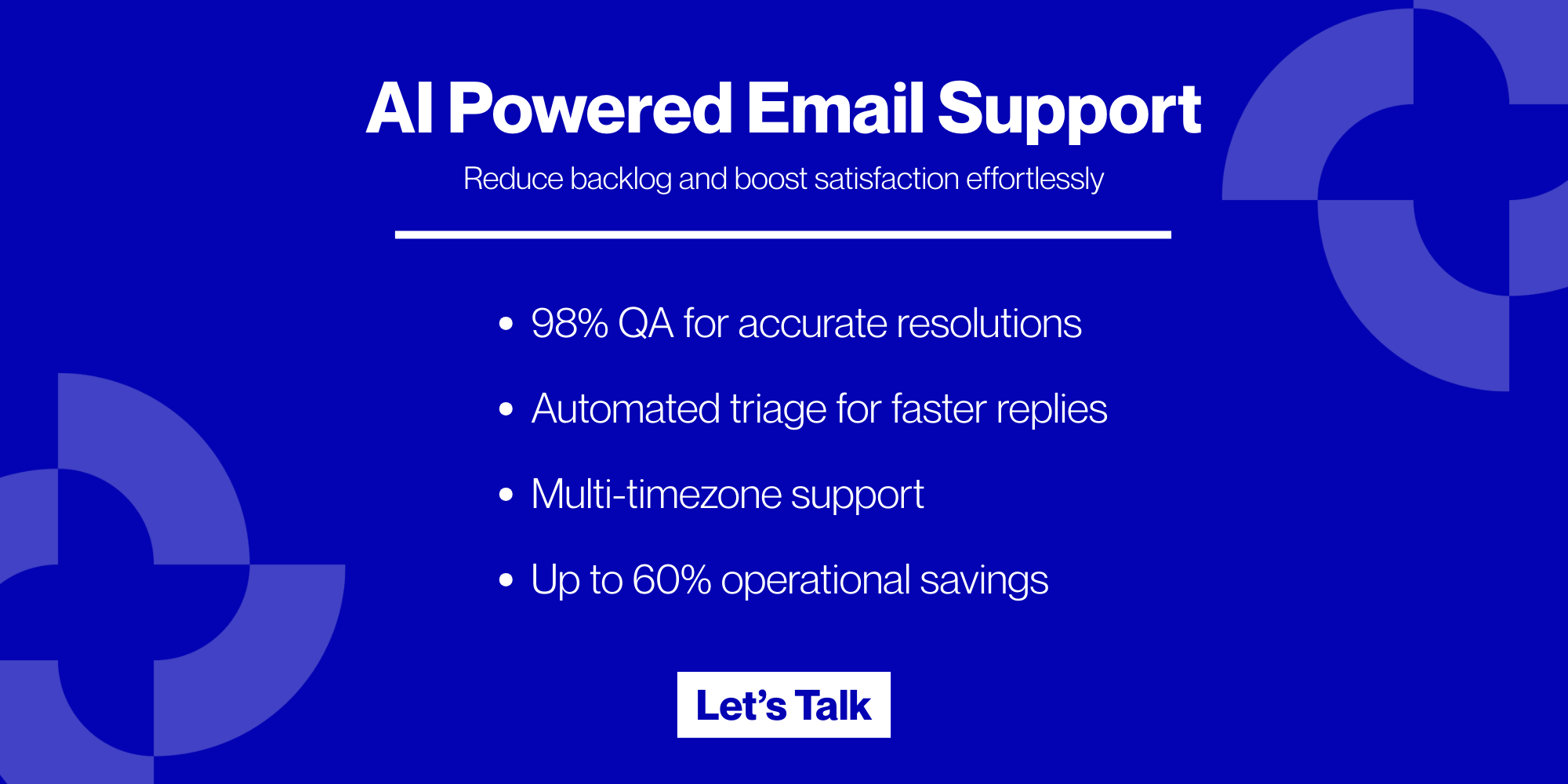Email response time is the duration between when a customer’s email reaches your inbox and when your team sends a reply. It is usually measured during business hours only and shows how quickly your business acknowledges and addresses customer needs.
A June 2024 survey from Emarsys found that 69% of consumers say email is their most preferred communication channel with brands. But does your business take email response time seriously?
Research found that the average email response time globally is around 12 hours. However, customer expectations are much higher, with 88% wanting a reply within 60 minutes.
In 2025, if your in-house team cannot satisfy such high customer expectations, they are more likely to lose trust and turn to a competitor. In contrast, by minimizing customer service email response time, you can lower customer churn and build long-term loyalty.
So, want your brand to stay ahead? Read this article to understand what email response time means, the established industry benchmarks, and how minimum customer service email response times can boost your brand loyalty.
What is Email Response Time?

Great customer service is all about timing! How long your business takes to reply when a customer reaches out determines the satisfaction level of your customers. Email response time is a metric that represents the time your business takes to reply to a customer’s email.
The clock starts when the email arrives in your inbox and stops when your team sends a reply.
This time is usually measured during your business hours only (and not 24/7). For example,
- Say a customer emails you at 7 PM.
- However, your business hours are 9 AM to 6 PM.
- Now, the timer starts the next morning at 9 AM.
It’s also important to note that automated replies like “We’ll get back to you in 24 hours” usually do not count as real responses. Most D2C companies and consumer brands earning $5M+ revenue only consider a reply written by a person while calculating the actual email response time.
Industry Benchmarks Related to Email Response Time

Not every email needs the same response time! Yes, customers expect quick replies when they need help or want to buy something. However, they are more patient with work or HR-related emails.
Below are some common benchmarks that show how long businesses usually take to reply compared to what customers actually expect:
| Context | Industry Average Response Time (Approximate Values) | Customer Expectation (Approximate Values) |
| Work Emails | 2 hours | Within 12–24 hours |
| Customer Service | 12 hours | Within 1 hour |
| Sales | 42 hours | Within 5 minutes (preferred) |
| Support | 24 hours | Within 24 hours |
| Marketing & HR | 48 hours | Within 48 hours |
Note: The table above represents approximate values based on popular market studies and research. Actual figures may be different. Kindly do your own research before acting.
5 Ways Fast Email Response Time Lets You Build Strong Brand Loyalty!

Fast customer service email response times directly influence the:
- Customer satisfaction
- Retention rates (or customer churn)
- Quantum of repeat business you can get
As a brand, if you can consistently deliver quick resolutions, your company can stand out in a highly competitive business environment. Let’s check out some other major benefits you can achieve by minimizing response time email:
1. Quick Replies Build Loyalty
An ASAP reply makes your customers feel respected. It shows their time matters to you. On the other hand, delays imply “business arrogance”.
The ill-effect? Many customers switch to your competitors. Thus, meeting this expectation is a simple way to earn trust and reduce your customer churn.
2. Enjoy More Free Marketing!
Minimum customer service email response time = Positive customer experiences. These experiences are what boost customer satisfaction and encourage people to recommend your business to others.
Studies show that companies with better response times enjoy higher retention rates and more word-of-mouth referrals. On the flip side, slow replies are one of the biggest reasons customers switch.
3. Speed Wins Sales
In today’s market, response time is a direct competitive advantage! Research shows 71% of sales go to the first business that replies (first responders). Thus, the faster you respond, the higher your chances of winning new customers over your competitors.
That’s why several D2C companies and consumer brands operating in multiple regions, like the US, UK, and Australia, prefer outsourcing email support services to leading agencies, like Atidiv. The benefit? They can easily cut costs (up to 60% with Atidiv) and achieve a higher ROI.
4. Better Operations Inside Your Business
Fast email response time doesn’t just help customers! They help your team, too. A quick turnaround reduces the need for constant follow-ups. This frees up their time, which can be invested in more productive tasks like improving customer support processes or new product launches.
Additionally, studies show that about 27% of Gen Z expect replies within 1 hour, and 92% of all customers want a reply within 24 hours. To let your staff achieve such high customer expectations, you can:
- Set up a “clear response time policy”
- Create detailed guidelines
- Regularly organize training programs for your customer support teams
5. Bigger Revenue Orders and Higher Sales
By replying to emails ASAP, you can build a strong fraternity of loyal customers. Usually, such customers are less sensitive to price changes. This gives your organization more flexibility to increase product/ service prices.
Gradually, as you keep building this group of loyal customers, you, on the other side, keep creating a stable revenue base. It particularly supports you when the market is uncertain.
12 Email Response Etiquette You Must Follow in 2025!

Did you know? As a business owner, you can expect an average ROI of $42 for every $1 you spend on email marketing. But that’s a reality only if you follow these established email response etiquette:
1. Strike the Right Tone
Every email should sound professional. Avoid jokes or sarcasm as “tone” can be misunderstood in writing. Tell your support team to keep the message polite + 100% clear. Usually, when this is done, the reader takes your response seriously.
2. Respect Reply Times
Don’t leave people waiting too long! Try to respond the same day, or at least within 5 days. Always remember that longer delays cause your customers to lose interest. Sometimes they even forget their own request, or start viewing your business as unresponsive.
3. Proofread Before Sending
Spelling or grammar mistakes in the subject or email body make your business look unprofessional. Train your team on the following:
- Tell agents to always re-read their email before sending.
- Suggest “reading aloud”, as this technique can easily spot errors.
- If possible, you can provide them with a grammar tool.
Lastly, to ensure 100% accuracy, you can review important messages yourself.
4. Remove the “Sent from iPhone” Tag
When you reply from your phone, the default line “Sent from iPhone” may appear at the bottom. This again looks unprofessional. An ideal email response etiquette is to replace that line with a proper email signature that includes your:
- Name
- Role
- Business details
5. Use the Recipient’s Name
Start your message with the person’s name or title. This small step shows respect and proves you’ve read their message. It also makes your email more personal and increases the chance they’ll respond positively (as it can reduce frustration to some extent).
6. Avoid Slang and Shortcuts
Don’t use text-message style abbreviations or slang words. That’s because they are:
- Confusing
- Misinterpreted
- Vague
- Amateur/ Novice
Instead, train your team to write complete words that anyone can understand without guessing the intended meaning.
7. Keep Attachments Relevant
Only attach what’s needed! Adding too many files overwhelms the readers. Sometimes, emails loaded with multiple attachments land directly in the spam folder.
Thus, train your agents on this email response etiquette. Tell them to share exactly what was requested or what’s directly connected to the conversation.
8. Acknowledge When Busy
If you can’t provide a full answer right away, send a short note to confirm you received their email. For example – “Thanks for your email, I’ll get back to you soon.” Then, follow up with your full response later.
9. Stick to the Subject
Reply only to what the original email is about. Don’t bring in unrelated topics, as it confuses the conversation. If you need to discuss something new, start a separate email thread with a clear subject line. Also, make sure your agents do not try to upsell or cross-sell in these support conversations.
10. Double-Check the Address
Before hitting send, make sure the email address is spelled correctly and you’re replying to the right person. Sending to the wrong contact not only wastes time but can also leak information to the wrong people.
11. Use “Reply All” Wisely
Please realize that not everyone copied on an email needs your response. Use “Reply All” only if your reply matters to the whole group. Otherwise, this email response etiquette requires you to respond directly to the person who needs it and not clutter others’ inboxes.
12. Offer Other Ways to Connect (Go Omnichannel)
Sometimes email isn’t the best option! If the topic is urgent or complex, suggest alternatives like a quick phone call or a meeting. Always include your contact details so customers know they can reach you another way.
As a D2C brand with 5+ employees, you can hire Atidiv to set up omnichannel messaging solutions. We are a leading digital customer experience solutions provider with 15+ years of experience.
Slow Responses = Slow Sales! Outsource Email Support Services to Atidiv in 2025
Ideal email response times are within hours (not days). As a D2C company or consumer brand operating in multiple regions, you can achieve this by:
- Tracking response metrics
- Setting clear policies
- Training teams to prioritize urgent messages
Alongside speed, you must follow good email response etiquette, such as using the right tone, addressing customers by name, proofreading, and keeping responses on-topic.
Are you a small business struggling to balance speed and quality? Outsourcing email support services is a smart option. We at Atidiv specialize in this by offering:
- Omnichannel email integration across live chat, voice, and social channels.
- High-volume ticket handling without delay or compromise.
- Flexibility to handle seasonal peaks
We also use intelligent systems for lead generation and outbound sales management. To know more, book your free consultation with us today!
Email Response Time FAQs
1. Can a slower email response time reduce sales/ new leads?
Yes! It has been observed that businesses with inefficient customer support teams often lose customers to their competitors. Also, the bitter experience prompts them to spread negativity. This significantly hurts both your existing customers and warm leads.
2. How fast should I reply to customer emails in 2025?
Industry benchmarks suggest within 24 hours. However, in sales or service-related emails, customers expect replies in minutes or a few hours. To achieve these expectations, you can outsource email support services to leading omnichannel customer experience solutions providers, like Atidiv.
3. How to handle too many customer emails?
You can prioritize by urgency or set automated acknowledgments. Still, if you are experiencing high volumes, you can consider outsourcing email support services to experts like Atidiv. Recently, our expert team saved $1.3M for a U.S. tire retailer and $500K annually for a UK firm by managing over 230,000 support tickets.
4. What looks unprofessional in an email?
Sloppy emails with grammar errors, missing names, or unclear tone look unprofessional. They damage your credibility and weaken customer trust. Thus, you must follow basic email response etiquette, such as:
- 100% clear language
- No ambiguity
- Use correct names
- Do proofreading
- Send polite greetings
These email response etiquette make your business appear reliable and respectful.

